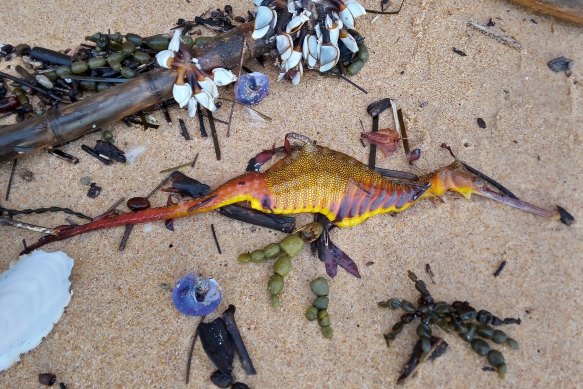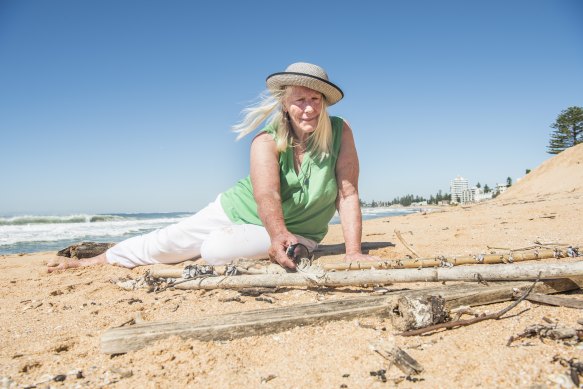This was published 2 years ago
‘My god, what’s happening?’: Dead weedy seadragons wash up on Sydney beaches
By Angus Dalton
Betty Ratcliffe has spent four years beachcombing Narrabeen’s shoreline at dawn, but she’d never spotted the bright yellow belly of a washed-up weedy seadragon. Then, in a week, she found seven.
“The first one I found had recently died; it was so vibrant, with orange, yellow and purple,” she said. “Over the next couple of days I kept finding more and more.”

A washed-up weedy seadragon on Narrabeen Beach following NSW’s record rains.Credit: Betty Ratcliffe
Seadragon expert Dr David Booth, a professor of marine ecology at the University of Technology Sydney, said more than 20 seadragons had washed up on Sydney beaches over the past fortnight.
“I’ve only ever seen one washed up,” he said. “It was like, ‘My god, what’s happening?’”
Dead weedy seadragons were found on the northern beaches, in Cronulla, Malabar, Botany Bay and on the Central Coast. Booth said it was not uncommon to find one or two among the flotsam after a storm, but he had never seen anything like this. He estimated that if 20 weedy seadragons had been found and reported, it was likely at least 50 had washed up in the Sydney area alone.
“I reckon it’s about 10 times the normal rate of wash-ups,” Booth said. “Clearly it’s a result of some combination of the shocking weather, pollutants being washed into the ocean and big surf.”

Betty Ratcliffe at Narrabeen Beach looking for weedy seadragons, which have washed up in record numbers.Credit: Steven Siewert
Weedy seadragons are “tough little devils” that can hang on to kelp in strong currents and live at a depth of about 10 metres, feeding on mysid shrimp, which are “basically tiny prawns”.
Usually, only the top three metres of seawater are affected by a storm, but Booth said it was likely particularly wild surf churned pollutants and muck down through the water column to the seadragons’ haunts.
Seadragons are “homebodies” that might not shift from their kelp-strewn home range by more than 20 to 50 metres in their lifetime, which can make the bony fish vulnerable to storm events.
Sydney seadragon numbers have fluctuated since population records began in the 1970s, although there has been a dip in numbers at some sites recently.
“At Kurnell, Botany Bay, there might’ve been seven to eight you’d see in a dive; now there’s two to three,” he said.
Booth works with hobby divers and citizen scientists who snap photos of seadragons they see on dives. The fish can be identified using AI, which can discern the differences between individuals based on the patterns dappled across their bodies, from their spot-spangled snouts to the streaks of violet on their necks.
Weedy seadragons, which are found only in Australian waters and can grow to 45 centimetres long, were downgraded from “near threatened” to “least concern” on the International Union for Conservation of Nature’s Red List of Threatened Species in 2017.
But Booth said their kelp habitats were under threat from climate change, and keeping across population data was vital, particularly after the mass wash-ups.
“This sort of storm is going to be more and more prevalent,” he said.
It is illegal to handle seadragon bodies, but Booth asks that washed-up seadragons are photographed and reported to him, and that divers and snorkellers keep their eyes peeled for survivors.
A guide to the environment, what’s happening to it, what’s being done about it and what it means for the future. Sign up to our fortnightly Clear Air newsletter here.